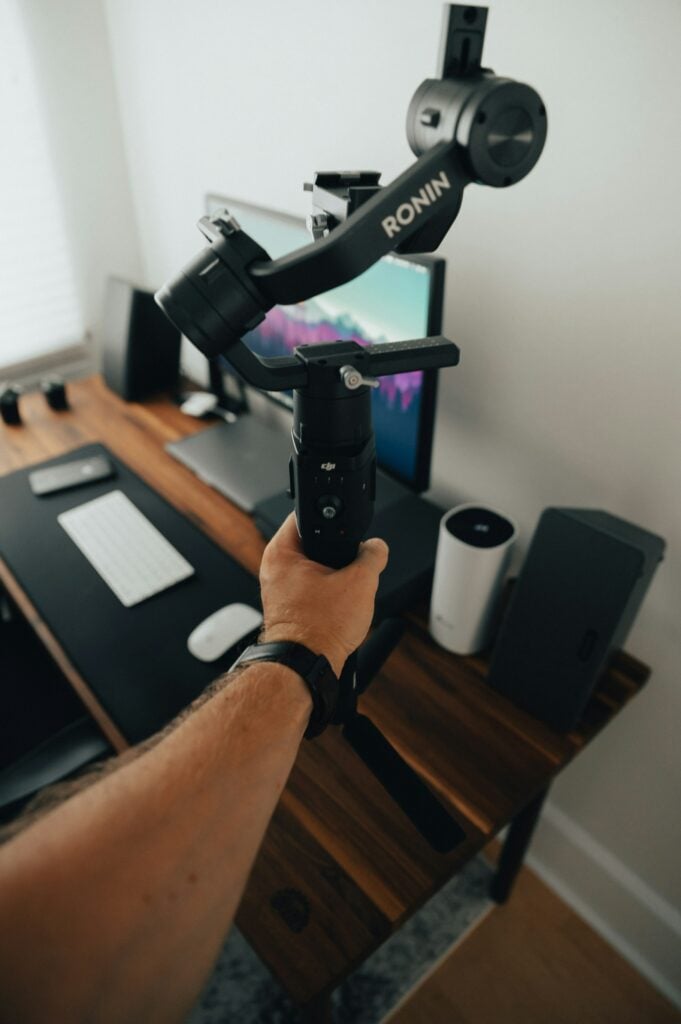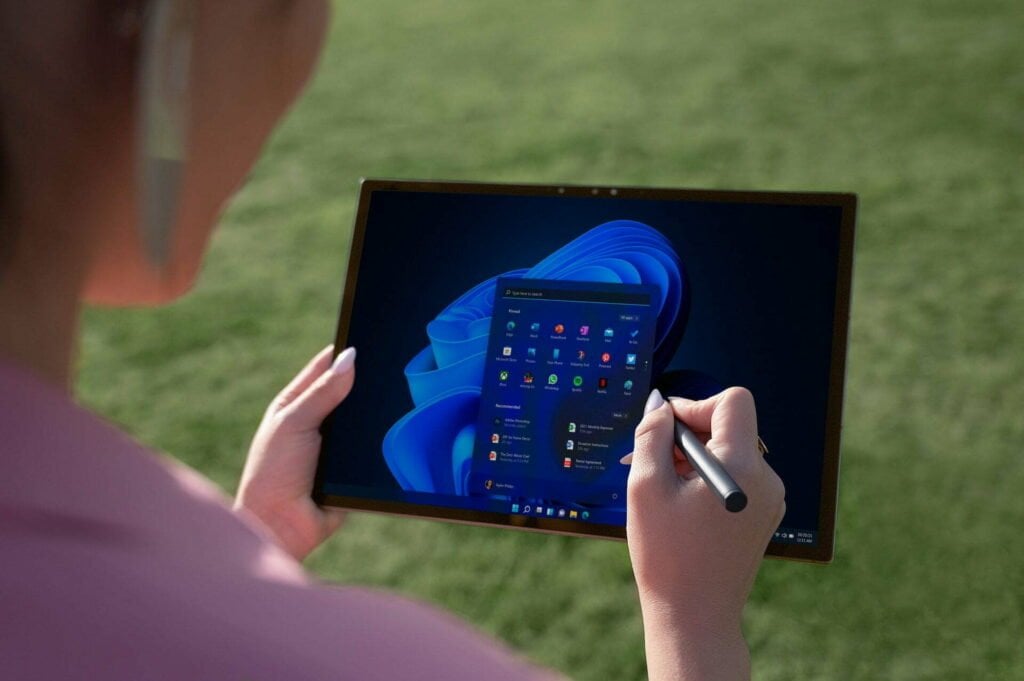

What is a Gimbal? 3-Axis Way to a Smooth Video

As Seen On
In the dynamic world of photography and videography, the quest for smooth, cinematic shots leads us to a pivotal innovation: the gimbal. A marvel of engineering, the gimbal has become the silent hero behind the scenes, ensuring that each frame captures not just an image but a story, unwavering in its clarity and stability.

What is a Gimbal?
At its core, a gimbal is a pivoted support that permits the rotation of an object about an axis. The essence of this device lies in its ability to maintain an apparatus such as a camera, steady and balanced, despite the movements of its handler. Imagine holding the reins of the wind; that’s what a gimbal does in the hands of a filmmaker or photographer. According to a report by KBV Research, the global EO/IR gimbal systems market size was valued at USD 608.2 million in 2021 and is expected to reach USD 1.3 billion by 2028, growing at a compound annual growth rate (CAGR) of 12.3% from 2022 to 2028.
Why Gimbals Hold the Key to Cinematic Mastery
A Dance of Axes: The 3-Axis Paradigm
Gimbals, particularly the three-axis variants, have revolutionized how filmmakers and videographers capture footage. These devices, celebrated for their versatility and innovation, offer a range of creative shooting modes that elevate ordinary footage to cinematic quality. Operating on pitch, yaw, and roll principles, gimbals adjust shot angles with remarkable precision, effectively combating the natural tremors of human hands.
This stabilization allows for smoother, more professional-looking footage that was once only achievable with bulky and expensive equipment.
From Selection to Mastery: The Journey of Utilizing a Gimbal
Selecting the right gimbal is a crucial first step in leveraging this technology to its fullest potential. The market offers many options, each with its unique features, from camera compatibility to control mechanisms. Choosing the right gimbal involves considering various factors, such as the camera’s weight, the desired level of stabilization, and the specific shooting conditions anticipated.
Following selection, mastering the balance and usage of a gimbal is essential. It includes understanding how to calibrate the device for optimal performance and familiarizing oneself with its various functions and controls to effectively capture dynamic shots and pans.
Calibration and Activation: The Heartbeat of Gimbal Operations
Calibration is a critical process that ensures the gimbal and camera operate harmoniously, maintaining perfect balance and stability during movement. This process might seem daunting at first but is simplified by the intuitive design of modern gimbals, which guide users through adjusting the pitch arms and ensuring the camera does not tilt or roll undesirably.
Following calibration, activating the gimbal’s functions tailors its response to the filmmaker’s intentions, easily capturing fluid tracking shots and creative pans. This level of control and flexibility makes gimbals an indispensable tool for achieving cinematic mastery.
The Impact on Cinematic Quality
The adoption of gimbals in filmmaking and videography has led to a democratization of cinematic quality, enabling content creators at all levels to produce smooth, engaging footage that rivals professional productions.
The ability to capture stable, dynamic shots without the need for heavy stabilizing gear has opened up new creative possibilities, from sweeping crane shots to intimate, steady close-ups that convey emotion and story with clarity and impact.
The Cinematic Arsenal: Gimbals vs. Steadicams
The cinematic tools of Steadicams and gimbals each offer unique advantages for filmmakers aiming to stabilize their camera movements and achieve smooth, professional shots. The choice between a Steadicam and a gimbal largely depends on the production’s specific needs, the type of camera being used, and the filmmaker’s budget and expertise.
Steadicam Overview
Invented in 1975, the Steadicam is a mechanical stabilization device that relies on inertia to provide smooth motion. It includes a sled for the camera, monitor, and batteries and requires the operator to wear a vest that distributes the weight across the shoulders and hips.
This setup isolates the operator’s movement from the camera, allowing for stable footage despite the operator’s movements. Steadicams are particularly effective at neutralizing the up-and-down movement of walking, enabling longer takes without the fatigue associated with handheld operation. However, they are generally more expensive and have a steeper learning curve.
Gimbal Overview
Gimbals, on the other hand, are electronic devices that stabilize footage by rapidly adjusting motors to counteract unwanted movement. First popularized for camera use by Movi in 2013, gimbals measure the camera’s position many times per second and adjust accordingly.
They are quicker to set up and easier to use than Steadicams, making them an appealing choice for those seeking a more straightforward solution. Gimbals are versatile, supporting a range of camera sizes and types, and many offer programmable modes for dynamic shots like hyper lapses. However, their reliance on power sources and potential for mechanical-looking movements are factors to consider.
Key Differences and Considerations
- Ease of Use and Setup: Gimbals are generally quicker to set up and more user-friendly, especially for those new to camera stabilization. Steadicams require more skill and time to set up properly.
- Weight Distribution: Steadicams distribute the camera’s weight across the operator’s body via a vest, allowing for longer shooting periods without fatigue. Gimbals require the operator to support the weight, which can lead to quicker exhaustion, especially with heavier cameras.
- Power Requirements: Gimbals need batteries to operate, which can add to the challenge of managing power supply during shoots. Steadicams, being mechanical, do not have this issue.
- Cost: Steadicams can be significantly more expensive than gimbals, both in terms of initial investment and the cost of hiring skilled operators for more complex rigs.
In the world of videography and photography, the introduction of gimbals has been a game-changer, offering unparalleled stability and fluidity in capturing movements. However, this innovative technology comes at a cost that varies significantly depending on the type, features, and camera compatibility.
Benefits of Using a Gimbal
Now that we’ve covered the basics of gimbals let’s explore some of the key benefits they offer:
Smooth and Stable Footage
The most obvious benefit of using a gimbal is capturing smooth and stable footage. By eliminating unwanted shakes and vibrations, gimbals allow you to create professional-looking videos, even if you’re moving around or filming in challenging conditions. It is particularly important when shooting action scenes, walking shots, or any other scenario involving camera movement.
Gimbals utilise advanced algorithms, gyroscopes, and motors to correct for any unexpected jolts or bumps while filming automatically. The motors in the gimbal are typically all brushless motors, which means they operate silently, ensuring that no unwanted noise is captured in your audio. This level of stabilisation is essential for creating high-quality, engaging content that keeps your audience hooked.
Versatility
Gimbals are incredibly versatile tools that can be used in various scenarios. Whether you’re shooting a documentary, a travel vlog, a short film, or a wedding video, a gimbal can help you achieve the desired look and feel. They are compatible with various types of cameras, from smartphones and action cameras to DSLRs and mirrorless cameras, making them accessible to content creators of all levels.
Moreover, gimbals offer a range of creative options, allowing you to experiment with different angles, perspectives, and transitions. You can easily switch between modes, adjust the speed, tilt axis and direction of the camera, and capture more details and emotions in your scenes. This versatility enables you to tell compelling stories and create visually stunning content that sets you apart.
Easy to Use
Modern gimbals are designed with user-friendliness in mind, making them accessible to both beginners and professionals alike. Most models feature intuitive controls and can be set up quickly, allowing you to focus on capturing the perfect shot rather than fumbling with complicated settings. Some gimbals even come with dedicated apps that offer additional features and creative possibilities, further simplifying the process of creating high-quality content.
Gimbals are much more portable and easy to use than traditional stabilisation equipment like dollies or Steadicams. They are lightweight, compact, and easily carried around, making them ideal for on-the-go content creation. This ease of use allows you to be more spontaneous and reactive when shooting, enabling you to capture those fleeting moments that make your videos truly special.
Improved Creativity
One of the most significant benefits of using a gimbal is the way it can help you unleash your creativity and take your videography to new heights. With a gimbal in your arsenal, you can experiment with camera movements and angles that would otherwise be difficult or impossible to achieve. It opens up a world of creative possibilities, allowing you to capture unique perspectives and create visually stunning content that engages and captivates your audience.
For example, you can use a gimbal to create smooth tracking shots, following your subjects as they move through a scene. You can also take three gimbals and use it to capture low-angle shots, giving your footage a more dramatic and cinematic feel. Additionally, gimbals enable you to create seamless transitions between shots, adding a professional touch to your videos.
Time and Cost Savings
Using a gimbal can also help you save time and money in the long run. By capturing stable footage on camera, you can reduce the need for extensive post-production stabilisation, which can be a time-consuming and costly process. It allows you to focus on other aspects of your production, such as colour grading, sound design, and editing, ultimately streamlining your workflow and increasing your efficiency.
Moreover, investing in a gimbal can be a cost-effective alternative to hiring a dedicated camera operator or renting expensive stabilisation equipment. While high-end gimbals can be pricey, many affordable options offer excellent performance and value for money. By owning a gimbal, you can take control of your creative vision and produce professional-quality content without breaking the bank.

The Spectrum of Pricing
Gimbals are available across a wide price spectrum, catering to amateur enthusiasts and professional filmmakers alike. On the lower end, smartphone-optimized gimbals offer an affordable entry point for hobbyists looking to enhance their mobile videography. These can start from as little as $100 and provide basic stabilization features that significantly improve the quality of mobile videos. The Zhiyun Smooth 4, for instance, is a popular choice among smartphone videographers, offering a plethora of buttons and preset shooting modes for under $100.
Moving up the scale, gimbals designed for DSLRs and mirrorless cameras introduce more sophisticated stabilization mechanisms, compatibility options, and features such as object tracking and automated shooting modes. Mid-range models, like the DJI RSC 2, are foldable and versatile, compatible with a broad array of DSLR cameras, priced around $499. They incorporate advanced technologies like ActiveTrack 3.0, which automatically tracks moving subjects, enhancing the production quality of videos.
For professionals demanding the highest level of stabilization and feature-rich options, premium gimbals such as the ZhiYun Weebill 2 justify their $1,099 price tag with comprehensive compatibility across Canon and Sony cameras, integrated touchscreens, and robust build quality. These high-end devices are engineered for heavy usage and complex shooting scenarios, offering features that can rival professional cinematography tools.
Factors Influencing Gimbal Pricing
- Compatibility: Gimbals are priced based on their compatibility with different cameras, from lightweight smartphones to heavier DSLR and mirrorless cameras. The broader the compatibility, often the higher the price.
- Stabilization Technology: The sophistication of the stabilization technology, including the number of axes for stabilization (2-axis vs. 3-axis), significantly affects the price. Three-axis gimbals, offering tilt, pan, and roll stabilization, are typically more expensive than their 2-axis counterparts due to their added stability.
- Features: Additional features such as wireless control, programmable modes, and extended battery life contribute to the cost. More advanced gimbals offer motion time-lapse, panoramic shooting, and object tracking, appealing to professional filmmakers and photographers looking for versatility and creative control.
- Build Quality and Brand: The build quality, durability, and brand reputation also play crucial roles in pricing. Renowned brands like DJI and Zhiyun, known for their reliability and innovation, may command higher prices than lesser-known manufacturers.

Making the Right Choice
When considering the purchase of a gimbal, it’s essential to weigh the price against your specific needs and usage scenarios. For hobbyists and those new to videography, a budget-friendly smartphone gimbal might be the perfect tool to explore stabilized videography.
Professionals and enthusiasts seeking to elevate their filmmaking capabilities may find the investment in a high-end gimbal worth its enhanced stability, features, and creative freedom.
In the realm of visual storytelling, the gimbal stands as a testament to the relentless pursuit of perfection. It’s not just a tool but a companion in the creative journey, ensuring that every motion, every angle, and every vision is captured with the precision it deserves. As we continue to push the boundaries of what’s possible in film and photography, the gimbal remains an indispensable ally, steadfast in its role, unwavering in its performance.
Top Gimbals for Different Devices
Gimbals for Smartphones:
- Insta360 Flow
- DJI Osmo Mobile 6
- Zhiyun Smooth 5S
Gimbals for Action Cameras:
- DJI Osmo Action Camera Gimbal
- FeiyuTech G6 Plus Action Camera Gimbal
- Zhiyun Crane-M2 Action Camera Gimbal
Gimbals for DSLR and Mirrorless Cameras:
- DJI Ronin-S
- Zhiyun Crane 3S
- Moza Air 2
Gimbals for Professional Videography:
- Freefly Systems MōVI Pro
- DJI Ronin 2
- Zhiyun Crane 3 LAB
- Zhiyun Weebill 2
- DJI RS 3 Pro
- Zhiyun Crane 3S
Frequently Asked Questions:
Can a beginner use a gimbal effectively?
Are gimbals suitable for all types of cameras?
Gimbals are designed to accommodate a range of cameras, from smartphones to professional DSLRs. The key is to select a gimbal that’s compatible with your camera’s weight and size.
Konger
Up until working with Casey, we had only had poor to mediocre experiences outsourcing work to agencies. Casey & the team at CJ&CO are the exception to the rule.
Communication was beyond great, his understanding of our vision was phenomenal, and instead of needing babysitting like the other agencies we worked with, he was not only completely dependable but also gave us sound suggestions on how to get better results, at the risk of us not needing him for the initial job we requested (absolute gem).
This has truly been the first time we worked with someone outside of our business that quickly grasped our vision, and that I could completely forget about and would still deliver above expectations.
I honestly can't wait to work in many more projects together!
Disclaimer
*The information this blog provides is for general informational purposes only and is not intended as financial or professional advice. The information may not reflect current developments and may be changed or updated without notice. Any opinions expressed on this blog are the author’s own and do not necessarily reflect the views of the author’s employer or any other organization. You should not act or rely on any information contained in this blog without first seeking the advice of a professional. No representation or warranty, express or implied, is made as to the accuracy or completeness of the information contained in this blog. The author and affiliated parties assume no liability for any errors or omissions.

